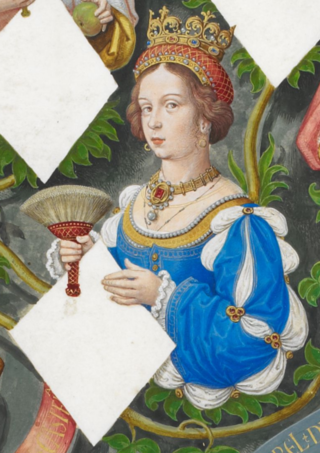| |||||
| Centuries: | |||||
|---|---|---|---|---|---|
| Decades: | |||||
| See also: | List of years in Portugal | ||||
Events in the year 1415 in Portugal .
| |||||
| Centuries: | |||||
|---|---|---|---|---|---|
| Decades: | |||||
| See also: | List of years in Portugal | ||||
Events in the year 1415 in Portugal .

Dom Henrique of Portugal, Duke of Viseu, better known as Prince Henry the Navigator, was a central figure in the early days of the Portuguese Empire and in the 15th-century European maritime discoveries and maritime expansion. Through his administrative direction, he is regarded as the main initiator of what would be known as the Age of Discovery. Henry was the fourth child of King Dom John I of Portugal, who founded the House of Aviz.

Portuguese colonization of the Americas constituted territories in the Americas belonging to the Kingdom of Portugal. Portugal was the leading country in the European exploration of the world in the 15th century. The Treaty of Tordesillas in 1494 divided the Earth outside Europe into Castilian and Portuguese global territorial hemispheres for exclusive conquest and colonization. Portugal colonized parts of South America, but also made some unsuccessful attempts to colonize North America.

The House of Aviz, also known as the Joanine Dynasty, was a dynasty of Portuguese origin which flourished during the Renaissance and the period of the Portuguese discoveries, when Portugal expanded its power globally.

Harfleur is a commune in the Seine-Maritime department in the Normandy region of northern France.

Elmina, also known as Edina by the local Fante, is a town and the capital of the Komenda/Edina/Eguafo/Abirem District on the south coast of Ghana in the Central Region, situated on a bay on the Atlantic Ocean, 12 kilometres west of Cape Coast. Elmina was the first European settlement in West Africa and it has a population of 33,576 people.

Duarte Pacheco Pereira, called the Portuguese Achilles by the poet Camões, was a Portuguese sea captain, soldier, explorer and cartographer. He travelled particularly in the central Atlantic Ocean west of the Cape Verde islands, along the coast of West Africa and to India. His accomplishments in strategic warfare, exploration, mathematics and astronomy were of an exceptional level.

Joan of Portugal was the Queen of Castile as the second wife of King Henry IV of Castile. The posthumous daughter of King Edward of Portugal and Eleanor of Aragon, she was born in the Quinta do Monte Olivete Villa, Almada.

The Kingdom of Portugal was a monarchy in the western Iberian Peninsula and the predecessor of the modern Portuguese Republic. Existing to various extents between 1139 and 1910, it was also known as the Kingdom of Portugal and the Algarves after 1415, and as the United Kingdom of Portugal, Brazil and the Algarves between 1815 and 1822. The name is also often applied to the Portuguese Empire, the realm's overseas colonies.

This article is a comprehensive list of all the actual possessions of the Portuguese Empire.

Portuguese maritime exploration resulted in the numerous territories and maritime routes recorded by the Portuguese as a result of their intensive maritime journeys during the 15th and 16th centuries. Portuguese sailors were at the vanguard of European exploration, chronicling and mapping the coasts of Africa and Asia, then known as the East Indies, and Canada and Brazil, in what came to be known as the Age of Discovery.
João de Trasto is the name sometimes given to an obscure Portuguese mariner, who is alleged to have captained the first exploratory expedition dispatched by Prince Henry the Navigator in 1415.

Lopo Vaz de Sampaio was the 6th Governor of Portuguese India from 1526 to 1529. He was also the captain of Vasco da Gama, a famous Portuguese explorer. During 1528–29, Lopo Vaz de Sampaio seized the fort of Mahim from the Gujarat Sultanate, when the King was at war with Nizam-ul-mulk, the emperor of Chaul, a town south of Bombay.
The Battle of Cannanore took place in 1506 off the harbour of Cannanore in India, between the Indian fleet of the Zamorin of Calicut and a Portuguese fleet under Lourenço de Almeida, son of the Viceroy Almeida.

Moroccan–Portuguese conflicts refer to a series of battles between Morocco and Portugal throughout history including Battle of Tangier, Fall of Agadir and other battles and sieges in the Moroccan coast.

Morocco–Portugal relations cover a period of several centuries largely historic, and to present not particularly substantial relations. Initial contacts started in the 8th century, when Muslim forces invaded most of the territory of the Iberian peninsula. After the Reconquista, Portugal would then expand into Africa, starting with the territory of Morocco, by invading cities and establishing fortified outposts along the Moroccan coast.

Abu Said Uthman III, was Marinid ruler of Morocco from 19 March 1398 to 1420, the last effective ruler of that dynasty. He ascended to the throne at the age of sixteen. He succeeded his brother, Abu Amir Abdallah ibn Ahmad. His forces were involved in an unsuccessful attempt to acquire Gibraltar from the Emirate of Granada in 1410. In 1415 the Portuguese seized the port of Ceuta. Abu Said Uthman III failed in an attempt to recover Ceuta, and was shortly after assassinated. His vizier gained control of the kingdom, establishing the Wattasid dynasty of rulers of Morocco.
Events in the year 1515 in Portugal.
Events in the year 1508 in Portugal.
Events in the year 1510 in Portugal.
Events in the year 1531 in Portugal.